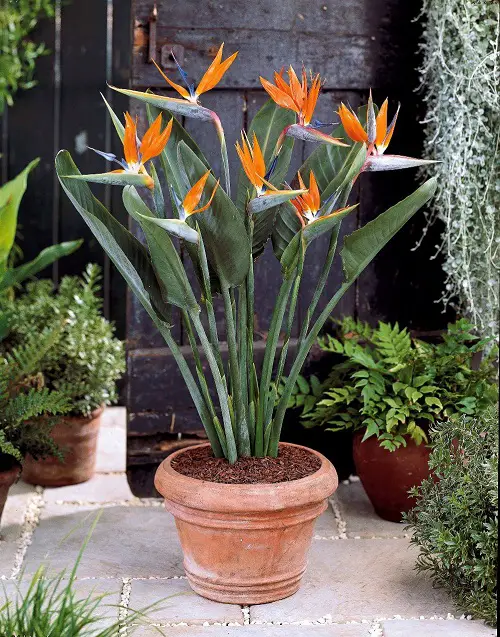Are you also confused between Traveler Palm vs. Bird of Paradise? Don’t know which one is which? Well, here are all the differences!
Are you looking to make a bold statement in your garden with exotic, tropical flair but confused between Traveler Palm vs. Bird of Paradise? Both plants are renowned for their striking appearance and ability to transport any onlooker into a lush, tropical paradise! Let’s have a detailed comparison!
Check out the difference between Magnolia vs. Tulip Tree here
An Overview of Traveler Palm

The Traveler Palm, scientifically known as Ravenala madagascariensis, is a stunning and unique tropical plant from Madagascar. Despite its name, it is not a true palm but a member of the banana family (Strelitziaceae).
It is characterized by its graceful, fan-shaped leaves that can reach up to 7-10 feet in length and are arranged fan-like, resembling the shape of a traditional hand fan.
Popular Types of Palm Plants
An Overview of Bird of Paradise
The Bird of Paradise plant, known by its scientific name Strelitzia reginae, is another captivating tropical plant from South Africa. It is part of the Strelitziaceae family and has earned its name from the unique, bird-like appearance of its flowers.
It stands out with its large, banana-like leaves and striking, bird-shaped blooms in various shades of orange and blue.
Common Bird of Paradise Problems and Solutions
Traveler Palm vs. Bird of Paradise
1. Appearance
- Traveler Palm: Known for its elegant, fan-shaped leaves, the Traveler Palm can reach impressive heights of up to 20-30 feet with a single trunk and distinct leaf arrangement. Its foliage is typically deep green with a glossy finish.
- Bird of Paradise: In contrast, the Bird of Paradise features large, paddle-shaped leaves that grow on long stalks. Its stunning bird-like flowers have a blend of orange and blue.
2. Growth and Size
- Traveler Palm: This plant is known for its tall and slender growth, with a single trunk that can reach considerable heights. Note that this plant grows slowly and may take years to reach the intended height.
- Bird of Paradise: Bird of Paradise plants tend to be smaller than Traveler Palms. They typically grow up to 4-6 feet tall and have a clumping growth habit, forming multiple stems.
3. Climate
- Traveler Palm: The Traveler Palm can thrive in both tropical and subtropical regions. It is more tolerant of cooler temperatures compared to the Bird of Paradise.
- Bird of Paradise: Ideal for tropical and subtropical climates with minimal temperature fluctuations. Bird of Paradise plants are less cold-tolerant and may require protection during colder weather.
Salvia vs. Veronica: All the Differences!
4. Propagation
- Traveler Palm: People mainly achieve the propagation of Traveler Palms by division or by growing from seeds, which can be a slow process.
- Bird of Paradise: Bird of Paradise plants can be propagated through division or by collecting and planting seeds, though division is the more common method.
5. Indoor vs. Outdoor Use
- Traveler Palm: Although you can grow Traveler Palms in containers, they are better suited for outdoor landscaping due to their height and size. You can use them to create privacy screens, line pathways, or provide shade in your garden.
- Bird of Paradise: Bird of Paradise plants are popular choices for indoor cultivation, thriving in pots and containers. They are best for offices, living rooms, and conservatories.
6. Space and Aesthetic
- Traveler Palm: If you have a large space and are looking for a dramatic, vertical element, the Traveler Palm’s tall, solitary trunk and fan-shaped leaves can create a stunning focal point.
- Bird of Paradise: Perfect for smaller spaces or to add a tropical charm in a more compact area. Their clumping growth habit and colorful blooms make them versatile landscaping choices.
7. Use in Landscaping
- Traveler Palm: Due to its tall, slender form and large, attractive leaves, people often use the Traveler Palm as a striking focal point in tropical gardens and as a natural screen or barrier.
- Bird of Paradise: Commonly, people use Bird of Paradise plants as ornamental shrubs or potted plants, adding a tropical flair to gardens, patios, and indoor spaces.
8. Hardiness and Maintenance
- Traveler Palm: Traveler Palms generally tolerate cooler temperatures and can handle a light frost. They require minimal care and can adapt to a variety of soil conditions.
- Bird of Paradise: Bird of Paradise plants are less cold-hardy and are best suited to tropical or subtropical climates. They require well-draining soil and regular watering, especially during their active growing season.
Aloe Vera vs. Snake Plant: All the Differences
Traveler Palm vs. Bird of Paradise – FAQs
Q1. Can Traveler Palms and Bird of Paradise plants be grown together in a single pot or container?
A1: While it’s possible to plant them together in a large container, it’s important to ensure that the container is spacious enough to accommodate the growth of both plants and that they have similar water and sunlight requirements.
Q2. What are the ideal soil conditions for Traveler Palms and Bird of Paradise?
A2: Traveler Palms prefer well-draining soil that is rich in organic matter, while Bird of Paradise plants thrive in a mix of well-draining soil with added organic material.
Q3. Do Traveler Palms and Bird of Paradise require regular pruning, and if so, how should it be done?
A3: Traveler Palms may require occasional removal of dead or damaged fronds, while Bird of Paradise plants benefit from the removal of spent flower stalks and damaged leaves. Pruning should be done with clean, sharp tools.


